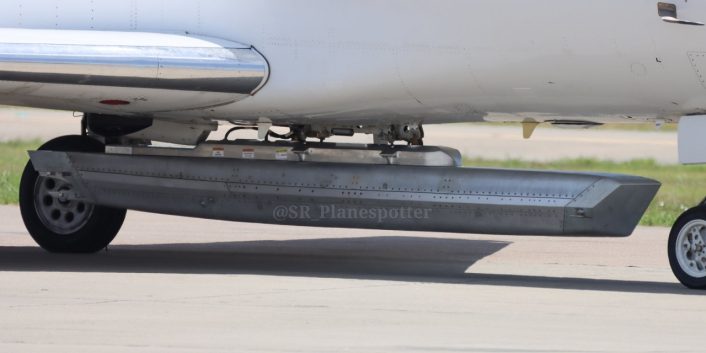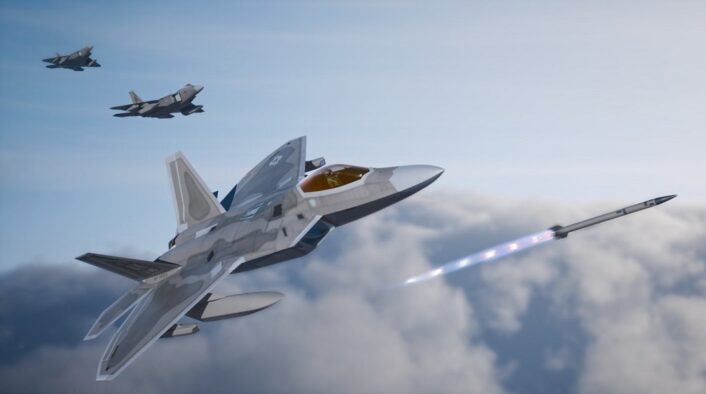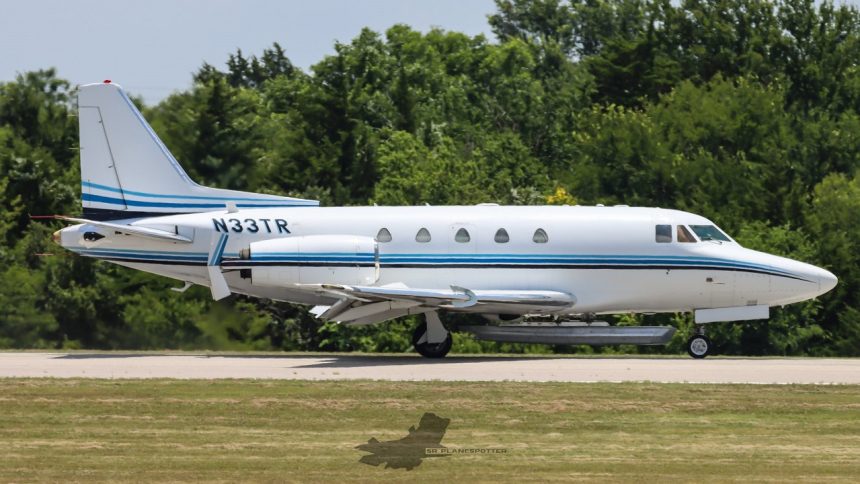The pod has reportedly undergone testing in the NTTR with the NT-43 aircraft used to validate low observable technology.
Few months after the first sighting of the new stealth external fuel tanks for the F-22A Raptor, we now get for the first time an up-close look of the Raptor’s new pod. The photos, captured by aviation photographer @SR_Planespotter, show the Rockwell Sabreliner 65 testbed returning to Mid-Way regional Airport, Texas, after spending some time at Nellis Air Force Base, Nevada.
The aircraft, belonging to Airborne Imaging, was reportedly employed to test the pod in the Nevada Test and Training Range (NTTR) with the shadowy NT-43, better known by its callsign RAT55, from its supposed name Radar Airborne Testbed. The aircraft is a highly modified Boeing 737 used to validate low observable technologies.
The NT-43 was recently spotted on flight tracking websites in at least a couple of occasions, headed for the NTTR. The involvement of this highly specialized aircraft makes sense as the U.S. Air Force needs to measure the impact that the new pod can have on the Radar Cross Section and emissions of the F-22.
Pod closeups pic.twitter.com/56FMN9Msxl
— 𝙎𝙍_𝙋𝙡𝙖𝙣𝙚𝙨𝙥𝙤𝙩𝙩𝙚𝙧 (@SR_Planespotter) July 1, 2024
The new pods have already been spotted during flight testing on an F-22 at the Air Force’s Plant 42 facility in Palmdale, California, in February 2022, as well as other occasions later. This time, however, we got what appears to be the closer look yet of the new pods.
The faceted pod under the Sabreliner sports a couple of differences compared to the best photos currently available. The first to catch the eye is the missing panel on the tail-end of the pod, which in previous photos was closed. Another detail is a pitot tube near the pod’s faceted nose, which however might not have been spotted in other occasions because of the distance.
The function of the pod is not yet clear. The latest budget documents mention an InfraRed Search and Track (IRST) sensor being developed for the F-22, which could be the sensor housed inside the two pods, although they could host also other capabilities in addition to the IRST.
Wow, cannot believe they’re working together. I can get super close to their aircraft at Midway but they’d definitely never let me know what they were testing. So cool. https://t.co/hEEkOIh3iF pic.twitter.com/1o2bnAe1h4
— 𝙎𝙍_𝙋𝙡𝙖𝙣𝙚𝙨𝙥𝙤𝙩𝙩𝙚𝙧 (@SR_Planespotter) June 26, 2024
The addition on the F-22 of an IRST system like the F-35’s Electro Optical Targeting System (EOTS) would require heavy and expensive modifications to the airframe, so a podded solution seems the most reasonable possibility. The addition of an internal IRST sensor on the Raptor was also considered not possible by Lockheed Martin some years ago.
It would be expected to see some kind of transparent surface associated with the IRST, however the surfaces on the nose of the pod appears to be opaque. We cannot exclude that there are two different variants of the pod, depending on the equipment inside.

The NT-43 aircraft
The highly secretive NT-43 is considered as the most highly modified Boeing 737. In fact, the initial 737-200 aircraft was modified with the addition of two massive radomes, one on the nose and the other on the tail, used to host two unspecified radars. On top of each radome, there is also an Electro-Optical/InfraRed (EO/IR) sensor turret, along with multiple antennas on the entire airframe.
As shown by the tail, the aircraft is assigned to the Air Force Materiel Command, although it is not known where it is officially based. The aircraft is usually seen flying around with the callsign RAT55 which, as we mentioned, should stand for its supposed name, Radar Airborne Testbed.
The NT-43A allow to perform measurements of both radar and IR signatures of an aircraft under realistic flight conditions from all angles around it, collecting data to validate low observable technologies, new coatings and so on. The shadowy aircraft is also often spotted flying in conjunction with the B-2A Spirit stealth bomber.
A detailed validation of the aircraft signature is necessary as it changes around the aircraft. For an instance, while the aircraft might have very little radar signature head-on, the radar cross section becomes increasingly larger if measured as viewed from the top or the side of the aircraft. The same applies similarly for the IR signature.
The F-22 upgrades
Some of the upgrades expected for the F-22 Raptor were unveiled in the Fiscal Year 23 budget request documentation and in an official artwork shared by Gen. Mark Kelly, then Commander of Air Combat Command. In the artwork we can see three Raptors loaded with new stealthy external fuel tanks, two underwing faceted pods and a new unknown air-to-air missile, but there are even more novelties in the documents, which unveils a previously undisclosed relationship between the F-22 and the development of the Next Generation Air Dominance (NGAD).
Two years after the upgrades were announced, we might have gotten, earlier this year, the first glimpse of the new stealthy external fuel tanks being developed for the F-22 Raptor. The aircraft was, in fact, spotted near the Mojave Air and Space Port and shows the Raptor with two fuel tanks, whose shape is reminiscent of the one shown in 2022.
The new tanks are officially known as Low Drag Tank and Pylon (LDTP) and designed to be stealthier and more aerodynamically efficient than the current 600-gallon fuel tanks. In the FY2023 budget request, the Air Force mentioned that the F-22 LDTPs are advanced technological designs providing increased persistence and range while maintaining lethality and survivability, critical to future mission execution and to maintaining Air Superiority.

The low drag tanks are intended to reduce drag, facilitate supersonic flight with external tanks and extend the range of the F-22. The pylons are equipped with smart rack pneumatic technology to accurately control ejection performance and smooth wind swept surface for minimum drag without store.
The last upgrade featured in the artwork is a new unknown air-to-air missile. While there are a number of air-to-air missile programs in the works, it is possible that the one in the image could be a representative design, which may or may not correspond to the real deal, for the highly secretive AIM-260 missile. So far, the missile has never been depicted in any kind of image and details about the program are very scarce.
The development of the AIM-260, also called Joint Advanced Tactical Missile, was first unveiled in 2019 and has been in the works at least since 2017. The goal of the new long-range air-to-air missile is to replace the AIM-120 AMRAAM (Advanced Medium Range Air-to-Air Missile) and counter the threat posed by the Chinese PL-15 missile, while avoiding any foreign threats being able to outrange the AIM-120.
Among the few known technical details, the new missile will be compatible with the AMRAAM dimensions, but obviously with greater range, and is planned to be carried in the F-22 weapons bay and on the F/A-18 at first, with the F-35 to follow. Flight tests are already in progress and the missile is expected to be fielded by next year. Because of these reasons, it would be reasonable to suppose that the one shown in the image could be at least a hint at the AIM-260.
Other upgrades mentioned in the budget request are a Mode 5 Identification Friend or Foe (IFF), Link 16 and Multifunction Information Distribution System Joint Tactical Radio System (MIDS JTRS), a new Operational Fight Program, advanced radar Electronic Protection, Embedded GPS/Inertial Navigation System (INS) Modernization (EGI-M), Open System Architecture (OSA), new encrypted radios.
Thanks again to @SR_Planespotter for allowing us to use the photos and make sure to follow him on X for more!









